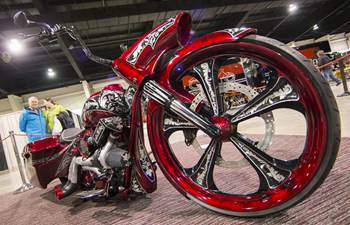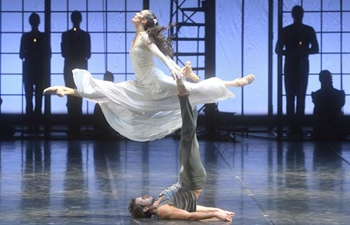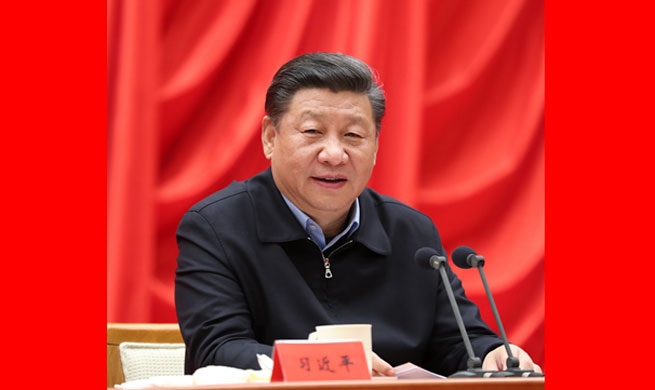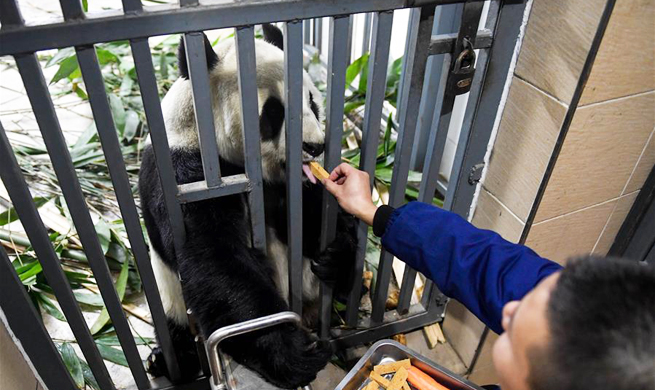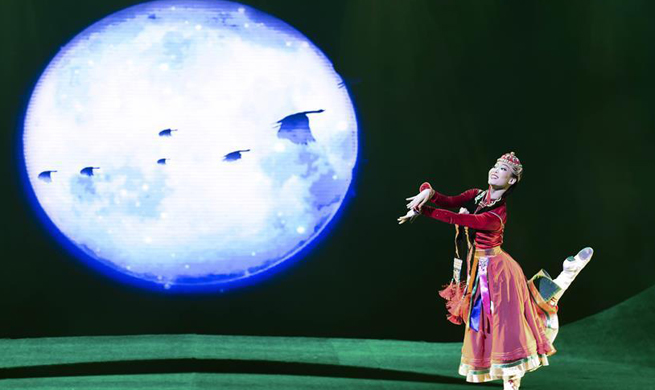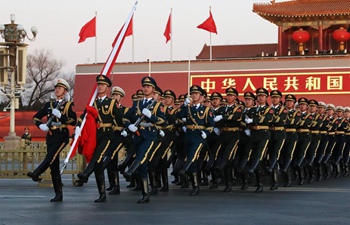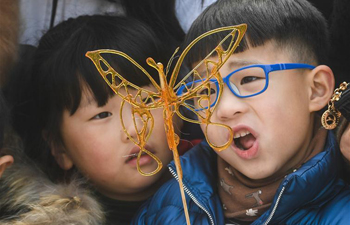by Julia Pierrepont III
LOS ANGELES, Jan. 6 (Xinhua) -- The total 2017 North American box office hit the 11 billion U.S. dollar mark for the third year in a row, falling 2.3 percent, but still the third highest of all time.
Disney drew the high card this year in the Hollywood North American box office sweepstakes, with their blockbusters bringing in 2.4 billion U.S. dollars for a whopping 21 percent of all Hollywood box office sales in the past year.
Warner Brothers, another perennial top performer, snagged second place with 18 percent of the box office and grosses of 2 billion dollars. Universal/Focus Features (1.65 billion dollars combined), 20th Century Fox/Fox Searchlight (1.4 billion dollars combined) and Sony/Columbia/Sony Classics (1.03 billion dollars combined) followed in 3rd, 4th and 5th place.
With studio slates skewing toward big budget tent-pole superhero franchises, more sophisticated audiences were left clamoring for more highbrow or emotionally-nuanced fare.
Stepping in to fill the popular niche markets for pithy dramas and quirky comedies that the studios left unfilled, the mini-majors were well rewarded, with Lionsgate edging out Paramount for 6th place with 885 million dollars in grosses vs Paramount's far slimmer 534 million dollars.
Though Disney's 2017 cume was slightly lower than last year's mind-boggling 3 billion dollars zenith, that was primarily because their production releases dropped from 10 blockbusters in 2016 to only 8 in 2017.
They have been actively building up their non-kid-oriented, live action slate, which produces movies with more mature themes and adult language that top stars want to sign on to.
At a recent Variety Networking breakfast, 21st Century Fox President, Peter Rice, a key player in the Disney and Fox merger, told Xinhua, "It's about who your key talent relationships are, about paying well, building the studio... Disney understands that."
This year also saw a seismic shift in audience viewing habits, ushering in some powerful new trends. Foremost amongst them is the rise of women - both in front of the camera and behind the scenes.
Disney's success this year was in large part due to their commitment to bringing strong female leads to the screen. It enabled them to field three of the four top box office smashes of the year in North America: "Star Wars: The Last Jedi" (533 million dollars), "Beauty and Beast" (504 million dollars) and the wild & wooly sci fi comedy sequel, "Guardians of the Galaxy Vol. 2" (390 million dollars).
And they are likely to continue to dominate the market as more female-centric flicks, such as Oprah Winfrey's return to the big screen in Madeleine L'Engle's sci fi classic, "A Wrinkle in Time;" China's "Mulan;" children's classic, "Mary Poppins Returns" and "Captain Marvel," hit theaters next year and the Disney-Fox merger adds more fuel to the fire, reuniting fan favorites, Iron Man, Hulk, Thor, Captain America, X-Men, Wolverine and the Fantastic 4 all under one roof.
It's likely no accident that the same year that gave birth to the "#me too" movement of Hollywood women speaking out against sexual harassment and abuse in the entertainment industry should also deliver the highest grossing, women-starring movies in almost 60 years.
For the first time since 1958, when "Auntie Mame," "South Pacific," and Elizabeth Tailor's "Cat on a Hot Tin Roof" took theaters by storm and topped the charts, women-starring vehicles nabbed the three top spots in the domestic box office: Daisy Ridley's "Star Wars: The Last Jedi," Emma Watson's "Beauty and Beast," and DC Comics runaway hit, Gal Godot's "Wonder Woman" (413 million dollars).
Geena Davis, the Academy Award & Golden Globe winning actress and founder of the Geena Davis Institute on Gender in Media, told Xinhua, "This shouldn't come as surprise. We used advanced machine learning software to crunch the real numbers, and statistics show that movies starring women make on average 16 percemt more than male-starring movies. It's time for Hollywood to wake up!"
When asked how the rejuvenated women's movement influenced her decision to play Beauty, held captive by the Beast in "Beauty & The Beast," actress, Emma Watson, explained in a recent interview with ETW that, "It's something I really grappled with at the beginning...But Belle actively argues and disagrees with (the Beast) constantly. She has none of the characteristics of someone with Stockholm Syndrome, because she keeps her independence, she keeps that freedom of thought."
Audiences can look forward to this female-centric trend bringing more female-starring vehicles to theaters in 2018 from the other studios too, including a Lara Croft "Tomb Raider" reboot, a "Charlie's Angels" reboot, "Ant Man and the Wasp," "Barbie," "Mama Mia: Here We Go Again", and, of course, "Wonder Woman 2", amongst others.
Emmy Award-winning Producer, Jeff Most, who is producing his own female-centric superhero movie, "Razor," based upon the hit comic book, told Xinhua in a recent exclusive interview, "audiences don't want to see a female superhero stepping into a male's shoes. They want to see women characters with characteristics that feel authentic to the female experience, as typified by 'Wonder Woman'."
Another big box office trend was the audience appetite for more human, even comedic superheroes. And in response, as more indie directors more in touch with deeper emotional nuance and characterization took the helm of giant studios pics, they took a lesson from life and allowed their superheroes to morph into emotionally-accessible guys you'd want to hang out with and maybe pop a brewsky.
As Patrick Stewart's character Charles Xavier in "Logan," puts it, "This is what life looks like - people who love each other. A home... Take a moment... Feel it."
So, while the macho "smash and bash" type movies, like "Transformers: The Last Knight" and "War for the Planet of the Apes" saw a steep fall off with disappointing domestic box office returns of only 130 million dollars and 146 million dollars, the more personal and humanly-fallible superheroes, like the bumbling adolescent Peter Parker in "Spider Man: Homecoming" (334 million dollars), the less confident, hammerless Thor in "Thor: Ragnarock" (312 million dollars), the hitting-rock-bottom-with-nothing-left-to-lose Wolverine in "Logan" (226 million), the kinder-gentler-with-an-infallible-moral-compass Diana Prince in "Wonder Woman", and the irreverent-rebel-with-a-heart-of-gold Peter Quill in "Guardians of the Galaxy Vol. 2" really racked up the big bucks, as viewers everywhere identified with heroes who felt and suffered as they did.
The inimitable Oscar-nominated Jeff Goldblum, co-star of "Thor: Ragnarok" welcomes this trend, "'Thor: Ragnarok' was wonderful. Taika, our director really gets it. It's more personal. It's inclusive. More real. He's a genius who brings 'touchy feely' to mainstream movies," Goldblum told Xinhua in a recent exclusive interview.
Patty Jenkins, director of "Wonder Woman," the highest grossing picture ever made by a female director, also understands what audiences are yearning for. "The greatest thing about Wonder Woman is how good and kind and loving she is, yet none of that negates her power. That is the great thing about what a superhero movie can be: thrilling, fun, exciting and bring out the best in you."





